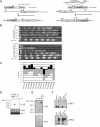Fungal functional genomics: tunable knockout-knock-in expression and tagging strategies
- PMID: 19286985
- PMCID: PMC2681610
- DOI: 10.1128/EC.00072-09
Fungal functional genomics: tunable knockout-knock-in expression and tagging strategies
Abstract
Strategies for promoting high-efficiency homologous gene replacement have been developed and adopted for many filamentous fungal species. The next generation of analysis requires the ability to manipulate gene expression and to tag genes expressed from their endogenous loci. Here we present a suite of molecular tools that provide versatile solutions for fungal high-throughput functional genomics studies based on locus-specific modification of any target gene. Additionally, case studies illustrate caveats to presumed overexpression constructs. A tunable expression system and different tagging strategies can provide valuable phenotypic information for uncharacterized genes and facilitate the analysis of essential loci, an emerging problem in systematic deletion studies of haploid organisms.
Figures

Similar articles
-
Development of new tools for studying gene function in fungi based on the Gateway system.Fungal Genet Biol. 2008 Aug;45(8):1147-54. doi: 10.1016/j.fgb.2008.04.011. Epub 2008 Apr 29. Fungal Genet Biol. 2008. PMID: 18550398
-
Molecular tools for functional genomics in filamentous fungi: recent advances and new strategies.Biotechnol Adv. 2013 Dec;31(8):1562-74. doi: 10.1016/j.biotechadv.2013.08.005. Epub 2013 Aug 26. Biotechnol Adv. 2013. PMID: 23988676 Review.
-
(Post-)genomics approaches in fungal research.Brief Funct Genomics. 2014 Nov;13(6):424-39. doi: 10.1093/bfgp/elu028. Epub 2014 Jul 17. Brief Funct Genomics. 2014. PMID: 25037051 Review.
-
Approaches to functional genomics in filamentous fungi.Cell Res. 2006 Jan;16(1):31-44. doi: 10.1038/sj.cr.7310006. Cell Res. 2006. PMID: 16467874 Review.
-
Functional analysis of pathogenicity genes in a genomics world.Curr Opin Microbiol. 2001 Aug;4(4):387-92. doi: 10.1016/s1369-5274(00)00222-8. Curr Opin Microbiol. 2001. PMID: 11495799 Review.
Cited by
-
The frequency natural antisense transcript first promotes, then represses, frequency gene expression via facultative heterochromatin.Proc Natl Acad Sci U S A. 2015 Apr 7;112(14):4357-62. doi: 10.1073/pnas.1406130112. Epub 2015 Mar 23. Proc Natl Acad Sci U S A. 2015. PMID: 25831497 Free PMC article.
-
Microtubule-based transport in filamentous fungi.Curr Opin Microbiol. 2012 Dec;15(6):637-45. doi: 10.1016/j.mib.2012.10.003. Epub 2012 Nov 2. Curr Opin Microbiol. 2012. PMID: 23127389 Free PMC article. Review.
-
High-resolution spatiotemporal analysis of gene expression in real time: in vivo analysis of circadian rhythms in Neurospora crassa using a FREQUENCY-luciferase translational reporter.Fungal Genet Biol. 2012 Sep;49(9):681-3. doi: 10.1016/j.fgb.2012.06.001. Epub 2012 Jun 10. Fungal Genet Biol. 2012. PMID: 22695169 Free PMC article.
-
An Inactivation Switch Enables Rhythms in a Neurospora Clock Model.Int J Mol Sci. 2019 Jun 19;20(12):2985. doi: 10.3390/ijms20122985. Int J Mol Sci. 2019. PMID: 31248072 Free PMC article.
-
The circadian clock of Neurospora crassa.FEMS Microbiol Rev. 2012 Jan;36(1):95-110. doi: 10.1111/j.1574-6976.2011.00288.x. Epub 2011 Aug 1. FEMS Microbiol Rev. 2012. PMID: 21707668 Free PMC article. Review.
References
-
- Aronson, B. D., K. A. Johnson, J. J. Loros, and J. Dunlap. 1994. Negative feedback defining a circadian clock: autoregulation of the clock gene frequency. Science 2631578-1584. - PubMed
-
- Bahler, J., J. Q. Wu, M. S. Longtine, N. G. Shah, A. McKenzie III, A. B. Steever, A. Wach, P. Philippsen, and J. R. Pringle. 1998. Heterologous modules for efficient and versatile PCR-based gene targeting in Schizosaccharomyces pombe. Yeast 14943-951. - PubMed
-
- Borkovich, K. A., L. A. Alex, O. Yarden, M. Freitag, G. E. Turner, N. D. Read, S. Seiler, D. Bell-Pedersen, J. Paietta, N. Plesofsky, M. Plamann, M. Goodrich-Tanrikulu, U. Schulte, G. Mannhaupt, F. E. Nargang, A. Radford, C. Selitrennikoff, J. E. Galagan, J. C. Dunlap, J. J. Loros, D. Catcheside, H. Inoue, R. Aramayo, M. Polymenis, E. U. Selker, M. S. Sachs, G. A. Marzluf, I. Paulsen, R. Davis, D. J. Ebbole, A. Zelter, E. R. Kalkman, R. O'Rourke, F. Bowring, J. Yeadon, C. Ishii, K. Suzuki, W. Sakai, and R. Pratt. 2004. Lessons from the genome sequence of Neurospora crassa: tracing the path from genomic blueprint to multicellular organism. Microbiol. Mol. Biol. Rev. 681-108. - PMC - PubMed
Publication types
MeSH terms
Grants and funding
LinkOut - more resources
Full Text Sources
Medical

